-
Best Class Registration Software for Nonprofits
Any nonprofit arts organization that offers classes or other educational programs to the public needs class registration software because it takes the burden off of administrative staff and streamlines the signup and payment process for students.
The right class registration software for nonprofits addresses the challenges of many arts organizations, including:
- Resource and staffing constraints. Whether your education program is a one-person show, run by volunteers, or requires part-time hires, the administrative burden of handling class registration is too much. You need software that will allow you to take a lunch break.
- No streamlined financial system. You are wasting time collecting and organizing payments, have difficulty in issuing refunds, and your bookkeeping is complicated.
- No integration with other systems. For class registration software that truly simplifies things for nonprofits, it needs to integrate with your existing donor management platform. No duplicating efforts or records, just a streamlined flow of data between the platforms.
- No time to learn a complicated new registration system. The right class registration software for nonprofits is easy to use for administrative staff, instructors, and students alike. You want something that you can start using right away, with minimal training.
Some arts education programs are still struggling to recover and grow enrollments again after the pandemic. Other programs may have more classes and students than they can manage. In either case, the right class registration software for nonprofits will help you streamline the registration process, automate as many tasks as possible like payments and waiting lists, and save you time and money.
In this post, we’ll take a look at four key features to help you decide which class registration software is right for you.
Streamlines and automates with online payments, customized registration forms, and more
Streamlined financial system that simplifies payments and refunds for staff and students
Integrations with other software to store and view customer data all in one place
The support you need to get you and your staff up to speed quickly
CourseStorm
Impossibly Simple Class Registration Software
Save time. Enroll more students. Perfect whether you offer classes in-person or online.
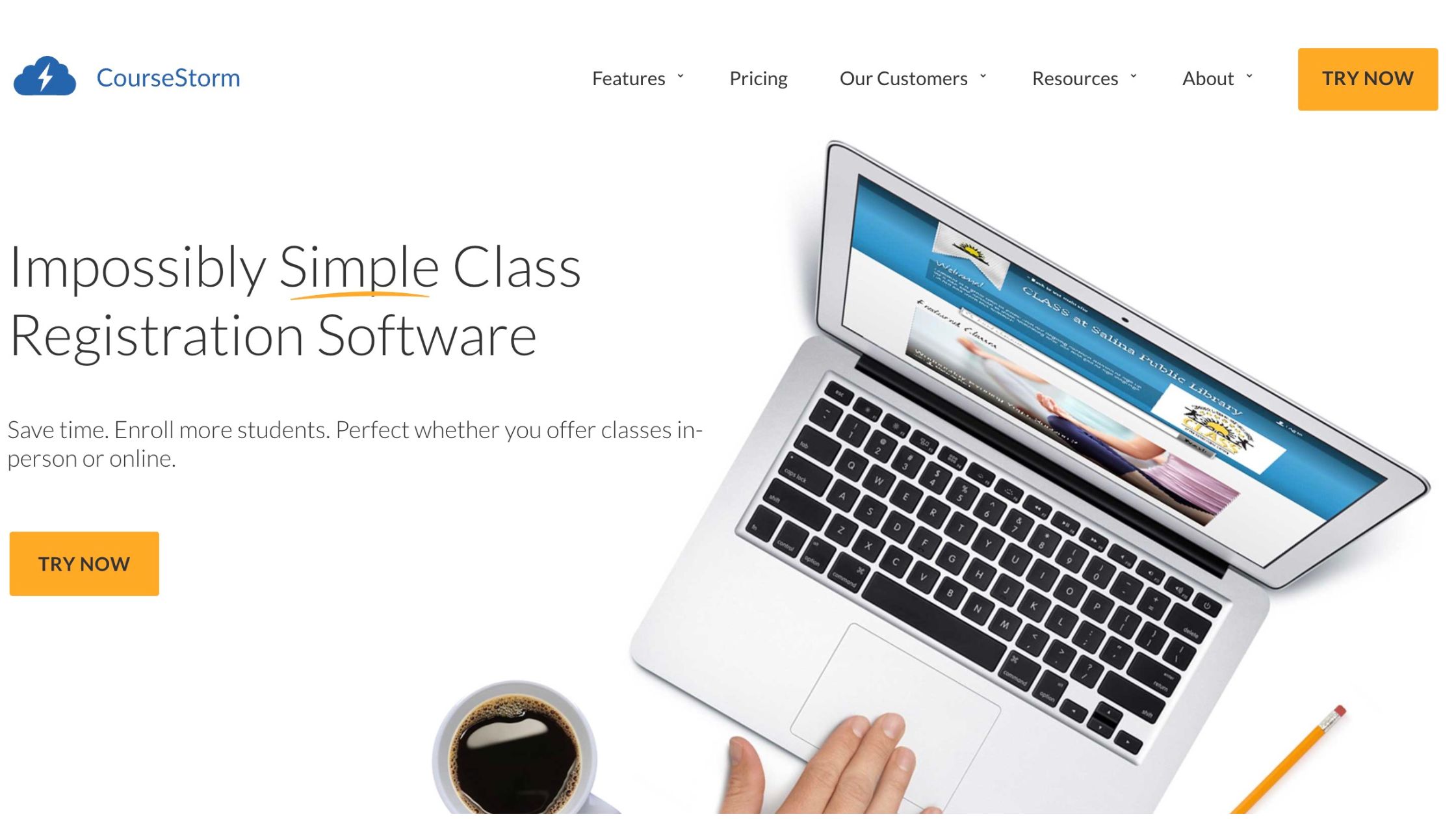
CourseStorm was designed to provide online registration that’s impossibly simple for people to use to sign up for classes. It’s easy to use, just a few clicks from start to finish, to increase your enrollments with no additional work on your part. We also created a streamlined process for programs to handle payments, refunds, and transferring students between classes, even if they’re different prices.
Create a sample course catalog in just a few clicks — no credit card needed.
Key Feature 1 – Streamlines and automates with features like online payments, customized registration forms, and self-serve waiting lists
The best class registration software provides a hands-off process that streamlines the registration experience for the student so that they are empowered to complete registration and payment online on their own without unnecessary calls to your staff.
The ability to customize registration forms can help you gather information while making the experience more pleasant for students.
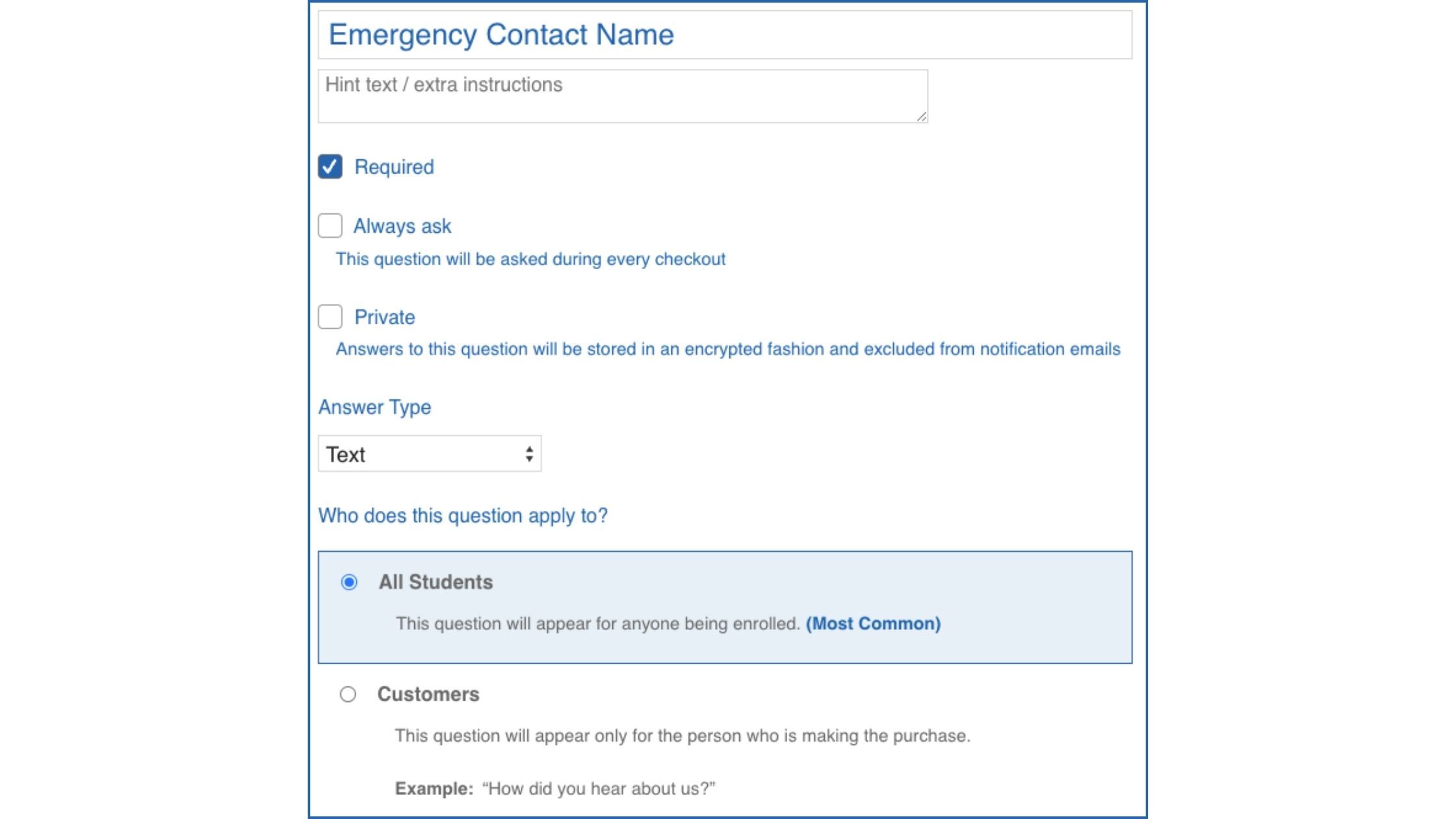
Let’s say you’re offering a kids’ theatre class that includes a field trip to see a play. You will want to collect emergency contact information for each student. You can easily customize the registration form in CourseStorm to include this.
Our waiting list feature allows programs to enable students to add themselves to the waiting list if a class is full. Then, if a spot opens up, they’ll be automatically emailed with a link to register.
Key Feature 2 – Streamlined financial system that simplifies payments and refunds for staff and students
Online registration and payment software simplifies payments, eliminating time spent collecting and organizing payments that come in by check or over the phone. Students pay online when they register, without any need for help from your staff. CourseStorm also makes it easy to transfer students between classes, even if there’s a difference in cost. And, because we know schedules and plans can change, we make it easy to issue refunds when necessary with just a couple of clicks. CourseStorm also makes it easy to give students discounts with promo codes, and reduce the barriers to registration by offering payment plans for big-ticket classes.
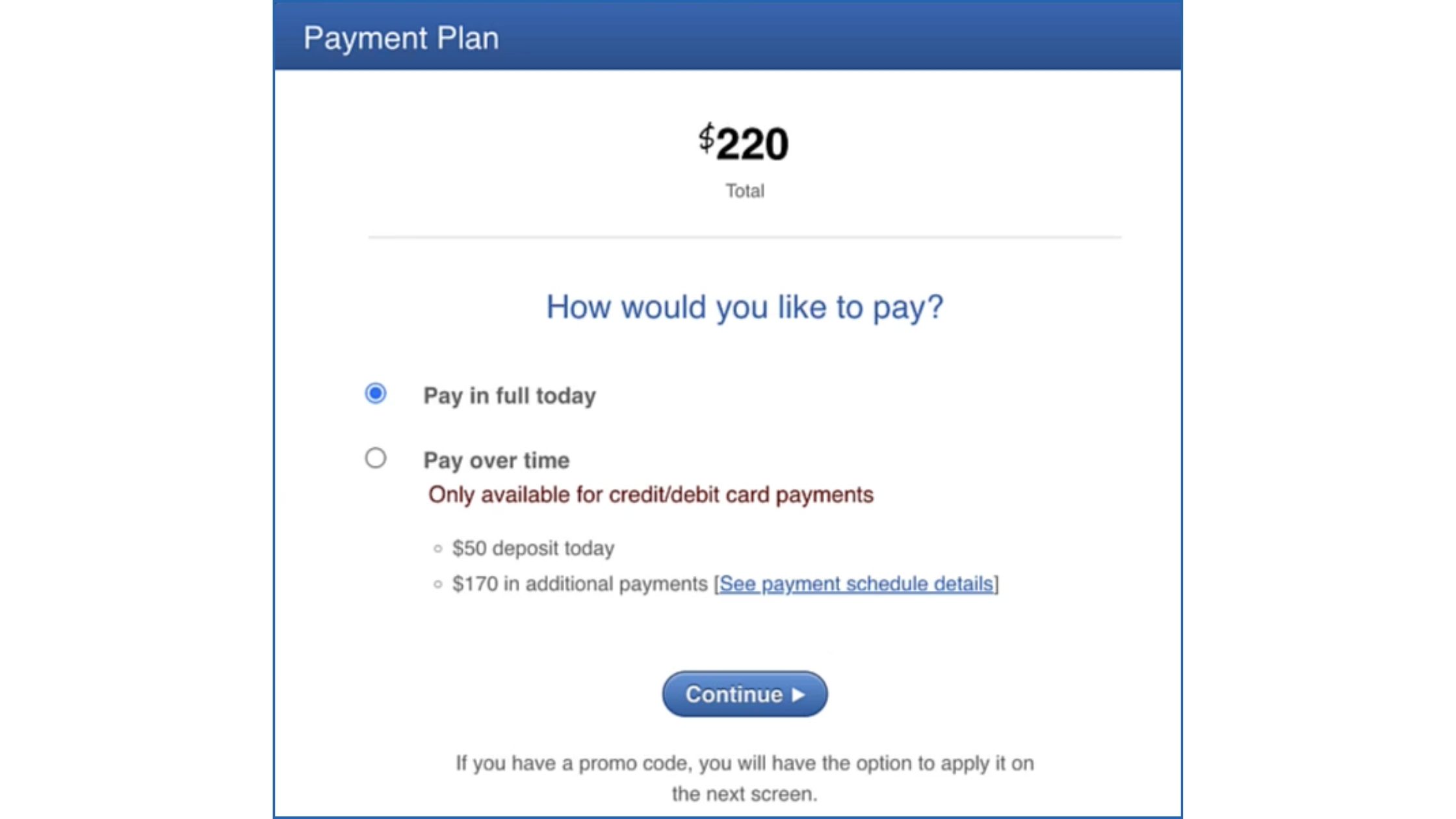
Key Feature 3 – Integrations with donor management platforms and other software give you a complete view of customers’ activity all in one place
In addition to everything listed above, your nonprofit could benefit from class registration software that integrates with the tools you’re already using. CourseStorm makes it easy to manage class registrations, donors, and campaigns with useful software integrations.
PatronManager Integration
PatronManager is a ticketing, fundraising, and marketing solution designed for arts programs. It’s used by theaters, music venues, festival organizers, and others who need to manage events. The PatronManager-CourseStorm integration gives nonprofits a more detailed picture of their patron, participant, and donor base.
Little Green Light Integration
Little Green Light (LGL) is a donor management software that helps nonprofits improve fundraising and donor relationships. The Little Green Light-CourseStorm integration lets CourseStorm class registration data appear automatically in LGL. Use it to include learners in appeal campaigns, manage communications, and send invitations for special events.
Other Useful Integrations for Nonprofits
Integrations with other software solutions can streamline data management so staff and volunteers can spend more time moving the mission forward. CourseStorm integrates with WordPress using a custom plugin, and with Mailchimp, Google Suite, and other essential tools through Zapier.

Key Feature 4 – The support you need to get up to speed quickly and train your staff
The right class registration for nonprofits is easy to use and requires minimal training. You want something that volunteers and staff members alike can quickly get comfortable with. That way you can spend less time training and more time serving participants.
A good class registration software streamlines the training process to simplify the user experience. CourseStorm offers a comprehensive Help Site. Get answers to your questions 24/7/365 from our help articles and videos. We also offer email and phone support for certain plans. All customers have access to onboarding videos. Depending on your plan, this may be live or on-demand recorded webinars.
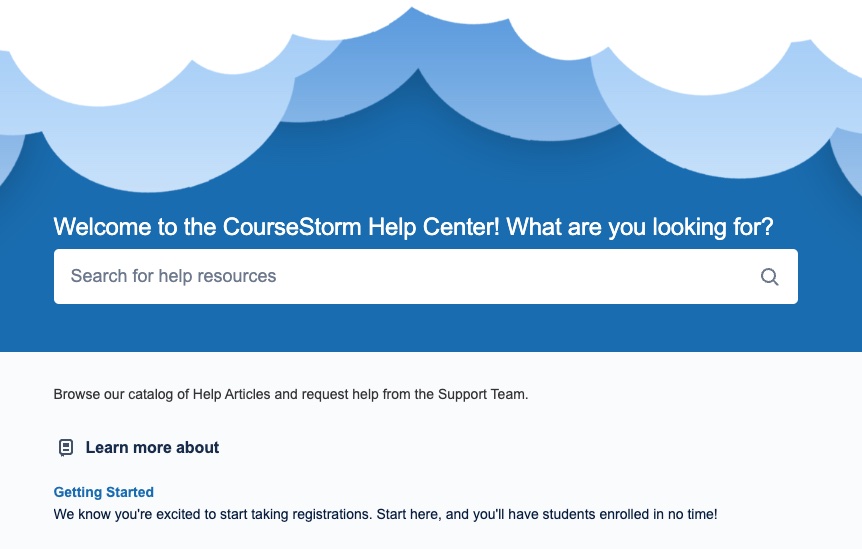
Create a sample course catalog in just a few clicks — no credit card needed.
Eliminate Up to 80% of Your Time Spent on Administrative Tasks
By now, we hope you have all the details you need to make an informed decision. The right software can make a big difference for your nonprofit’s education program. It can simplify the work of staff and volunteers while creating positive experiences for participants.
We designed CourseStorm as the streamlined and simple solution for community, arts, and nonprofit organizations. But you don’t have to take our word for it. Start your free trial of CourseStorm today and see for yourself why so many nonprofits have chosen CourseStorm.
-
Why You Should Promote Experiences as Gifts and How to Do It for Christmas Shoppers
With the holiday gift-giving season approaching fast, arts organizations are looking for ways to promote their classes to Christmas shoppers and those celebrating other winter holidays. The good news is that many people are already on board with the idea of giving experiences as gifts. What holds them back is often the logistics. It’s easy to stick a video game under the tree, but how do you package violin lessons?
Help holiday shoppers give the gift of an experience like classes or tickets to a performance by highlighting all the reasons these make great gifts.
Arts organizations can help holiday shoppers give the gift of an experience like classes or tickets to a performance by highlighting all the reasons these make great gifts.
If you want Christmas shoppers and other gift-givers to consider purchasing classes for friends and family, you first need to highlight all the reasons your classes make great gifts. Then you have to support the gift-giving experience by helping them package their gift in a way that feels meaningful. We’ll address this one step at a time.
Reasons to Give Experiences as Gifts Rather Than Stuff
Consumer Reports found that, among all age groups, people derive more happiness from experiences than from material goods. The desire for quality time with friends and family has increased more than ever since the pandemic. Even so, Christmas shoppers may not think of your classes or performances as possible gifts unless you explicitly make the connection for them.
Giving experiences as gifts gives the recipient skills or memories that last a lifetime. It’s also more eco-friendly and a great last-minute gift option!
Here are some ways you can frame your marketing messages to reach Christmas shoppers and other gift-givers:
A gift for a lifetime. As children grow up, they may fall out of love with this year’s trending toy, but they’ll always have the skills they learned in pottery class. Creating something with your own hands is exciting no matter what your age. Young children can get a kick out of making art to hang on the family fridge, while teens may be excited to learn how to knit a scarf themselves. Creative aging programs are built upon the idea that older people want to continue to build skills as they age, as well.
Give the gift of connection. Our world is suffering from a loneliness epidemic. A new poll found that nearly 1 in 4 adults feel lonely, with the rates highest among young adults ages 19 to 29. Participating in art classes and activities helps provide a sense of community and connectedness. This is especially important for certain populations like veterans.
It’s more eco-friendly. A recent study by NielsenIQ found that 78% of U.S. consumers say that a sustainable lifestyle is important to them. If you know your community is environmentally conscious, play up that angle in your class marketing efforts. An educational experience beats unwanted material goods ending up in the trash.
Experiential gifts are a smart last-minute option. Let’s face it: the holidays are a busy time of year. It can be tough to shop, wrap, and ship gifts in time. If you have rolling admissions for your classes, open seats at an upcoming performance, or other opportunities available that would make good gifts, let your customers and community know. Then all they have to do on the actual holiday is give the recipient a card or email notifying them of their gift.
Experience Gifts for Couples: Classes They’ll Love
Offering couples classes is a great way to attract customers who want to give experiences as gifts. Cooking classes, ballroom dancing, and jewelry making are all good gift experiences for couples, but those are just the beginning. Mixology classes, a terrarium workshop, or anything else couples can do together make great gifts.
From cooking classes to jewelry making to mixology, offering couples classes is a great way to attract customers who want to give the gift of quality time and connection.
CourseStorm’s head of marketing, Nic, and her husband attended a restorative foraging class in their community. Guided by a sustainability expert from a local university, they walked around outdoors and identified lots of native and non-native plants and learned about how to process acorns for acorn flour. “It was fascinating to learn about foraging through this lens and to try something new,” she said.
Pro tip: Offering couples classes is also a great way to boost your website’s SEO and help people find your classes online. “Couples classes near me” is a very popular search term, so if you offer couples classes, be sure to state this clearly on your website, in your online course catalog and course descriptions, and on your social media platforms.
For more specifics, read our article on how to promote couples classes for Valentine’s Day, birthdays, anniversaries, and other holidays throughout the year.
Christmas Shoppers Want Something to Wrap
Even Christmas shoppers who are already convinced that giving experiences as gifts is a good idea may hesitate because they want the recipient to have something to unwrap. Many people find joy in watching someone unwrap a gift. This is especially true for people giving gifts to kids. Help shoppers overcome this obstacle by offering something tangible to go with the experiential gift.
- Branded merch – If you already have branded merchandise, offer a magnet, mug, tote bag or tee-shirt to anyone purchasing classes as gifts during the holiday season.
- Gift shop merchandising – If your organization has a gift shop, set up a small section with inexpensive gifts relevant to different classes. This could include pencils and a sketchbook for an art class, an adult and child apron set for a cooking class, or Shakespear magnets and stickers for a theater class.
- Printed certificates – Printed certificates can be placed in an envelope or even wrapped in a box with some tissue paper. Print some fillable certificates on high-quality paper and give them away with gift orders.
Many people find joy in unwrapping and watching others unwrap a gift. Help holiday shoppers by offering something tangible to go along with the experience they’re gifting.
Even if your organization doesn’t offer these things, with a bit of imagination, you can help your customers come up with a tangible item to gift alongside the experience. Here are just a few ideas:
- Paintbrushes, pencils, or pastels along with a sketchbook for someone you’re gifting a session of art classes
- Funny Shakespeare magnets or stickers for a teen you’ve signed up for theater camp
- An adult and child apron set to go along with a grandparent-and-grandchild cooking class
- A basket of colorful yarn for someone enrolled in a knitting or crochet class
- A monogrammed journal for a person you’re giving a writing class or poetry workshop
- Safety glasses or work gloves to go along with a wood or metalworking workshop at a makerspace
For more creative and unique ideas to go with your experiential gifts, check out UnCommon Goods and MoMA Design Store. Visitors can search by interest, price range, recipient, and even eco-friendly products.
Making it easy for people to give your classes as gifts, such as by offering group registrations and promo codes, is a smart marketing strategy all year round.
Making it easy for people to give your classes as gifts is a smart marketing strategy all year round. Consider offering discounts or promo codes to encourage gift-giving, and allow group registrations to simplify the process for students who want to give and take a class with a loved one. CourseStorm has all of these features and more.
-
Creative Arts Classes in Theater, Music, and Art For Veterans
Honoring our veterans is about more than parades and bumper stickers. It’s not something that should happen just on Veteran’s Day or Military Appreciation Week. We honor our veterans when we offer them support all year round. Classes in theater, music, and art for veterans give them a point of connection, an opportunity to learn, and a chance to share their unique stories and viewpoints.
Arts organizations across the U.S. offer classes in theater, music, and art-making for veterans to foster connection and self-expression.
Organizations across the country have made a special effort to provide these valuable experiences for veterans and their families. Here is a closer look at how arts programs are supporting those who served and some thoughts about how your organization can start offering classes in art for veterans.
Art as a Tool for Connection
Anyone can benefit from art classes. Engaging with the arts provides stress relief, can improve social connection, and empowers self-expression. All of these have been linked to better mental and physical health.
These benefits might be especially valuable to veterans. Many veterans find that transitioning back to civilian life can be stressful. Service members who have benefited from the structure and camaraderie of military life may feel lonely and disconnected outside that system. The stresses of military service can also create unique mental and physical health challenges.
Dedicated programs in art for veterans can help ease the transition back to civilian life.
When organizations offer dedicated programs in art for veterans, they help ease the transition. Even veterans who served years or decades ago carry stories and perspectives that can be expressed through art.
Veterans in Our Communities
According to the U.S. Census Bureau, there are about 16.2 million veterans in the United States. That equates to about 6.2% of the adult population. Some states have a greater proportion of veterans than others. In Alaska, Wyoming, Virginia, and Maine veterans make up around 10% of the population. California, Utah, New Jersey, and Massachusetts hover around 4%.
While older males make up the majority of the veteran population, arts organizations might be interested to know that the number of female veterans is rising. By 2040, women will make up 17% of the veteran population.
Also, while many people associate military service with war, the second-largest cohort of living veterans served during a time of relative peace. So although all veterans make sacrifices to serve our country, these are not always combat related. Before you create a program for veterans, consider who you hope to serve.
Meeting Multiple Needs With Art for Veterans
Veterans may share the common experience of military service, but each is a unique person with unique needs. A diverse range of theater, music, and art for veterans programs help meet those needs in creative ways.
Community and Connection – Organizations like the War Memorial offer Veterans Artmaking classes as an opportunity for veterans to meet and connect with each other over art. While veterans are welcome to attend the full range of events, classes, and activities at the War Memorial, this artmaking class offers a special opportunity just for them.
Sharing Stories – The CreatiVets songwriting program partners veterans with musicians and songwriters who can help them tell their stories through song. Playing these songs for friends and family can enable veterans to tell stories they might not otherwise have shared.
Serving Multidimensional Needs – Veterans experiencing incarceration have found opportunities for self-expression and healing through theater performances organized by the Marin Shakespeare Company. In these programs, veterans incarcerated in California state prisons take part in theatrical performances led by a registered drama therapist.
Personal Fulfillment – VetRep’s Acting and Playwrighting Classes offer veterans a chance to express themselves and share their talents. In addition to classes, the program offers live theater events, script competitions, and a podcast featuring long-form conversations with veterans in the arts.
Career and Vocational Supports – Organizations like Nobel Desktop offer graphic design and mobile graphics bootcamps for veterans who want to quickly learn arts and design skills to support their transition to a new career. GI Bill-eligible veterans can use their benefits to help pay for programs like these.
How to Offer Classes in Art for Veterans
Reaching veterans in your community might sound like a big challenge, but it might be easier than most organizations realize. Follow these best practices to develop an arts program that meets the needs of veterans.
- Don’t Assume – The demographics of the veteran population are shifting. Don’t assume that all veterans are male, served in combat, or have service-related health conditions. You can certainly create programs to serve those specific populations, just know that many service members fall outside of those categories.
- Get Insight From a Veteran – The best way to create arts programs that serve veterans is to ask them what they need. If you don’t already have veterans in your organization, reach out to your community and ask for input. You can also contact a local veterans service organization or the local branch of the Department of Veterans Affairs.
- Plan for Your Purpose – Decide how you hope to serve veterans with your arts programs. Are you supporting mental health, creating community, or offering career support? Clearly identify your purpose and include it in your marketing materials for the class.
In short, avoid making assumptions about veterans’ backgrounds and seek input from veterans themselves to tailor programs to their needs. By actively involving veterans in the planning process and recognizing their diverse needs, you can offer classes that make a meaningful and lasting impact on their lives.
For more on how to develop classes with particular audiences in mind, learn about how to develop and use student personas.
-
Smart Student Retention Strategies to Keep Learners Coming Back to Your Classes
Keeping the customers you have is easier than attracting new ones. People who have previously enrolled in your classes already know and trust you. Offering high-quality courses is a good start, but this alone is not enough to create student loyalty. You also need smart student retention strategies to keep learners — and their friends and families — coming back for more.
It all comes down to each person’s experience with your organization. The right student retention strategies can keep them engaged from registration through follow-up. You want to make it as easy as possible for someone to enroll in your program. Then, offer support and a sense of community to keep them coming back.
We’re sharing some useful student retention strategies we’ve discovered over years of helping learning experience providers like you.
Through our years helping learning experience providers register and retain students, we’ve discovered some useful student retention strategies. Now we’re sharing them with you.
But first, we need to make an important point: every program needs to think about student loyalty, even if you offer courses learners are unlikely to repeat.
Student Retention Strategies Matter, Even If You Offer One-Off Courses
When you provide learning experiences, it’s not always obvious why student loyalty is important. You might be teaching professional development courses that students take only once in their career. Maybe you offer a retirement planning class, and people only plan for retirement once. This can make it feel like student retention strategies aren’t necessary for you.
Retention is about more than repeat business. It’s also about creating a community of people who will happily recommend you to others.
However, even programs that offer one-off classes can benefit from thinking about student loyalty. Retention is about more than repeat business, it’s also about building a community of people who will happily recommend you to friends, family, and coworkers.
If you have done the work of creating a high-quality experience, students are more likely to recommend your program. Increase the odds even more by putting smart student retention strategies in place.
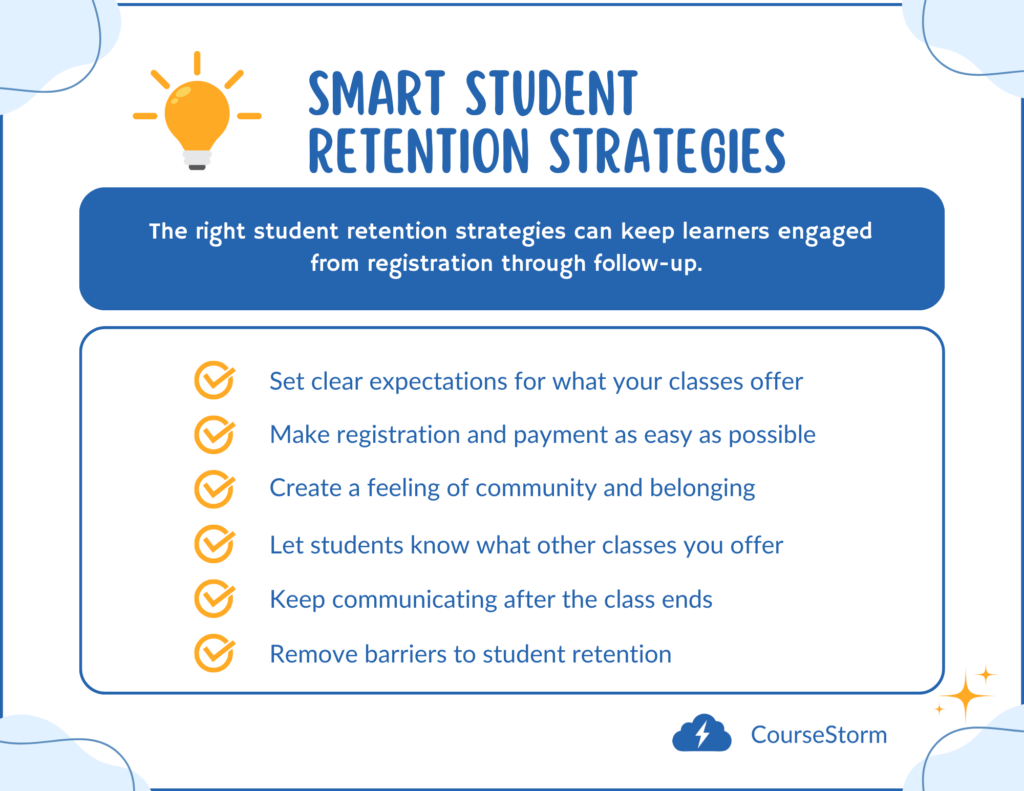
6 Student Retention Strategies to Apply Today
1. Set Clear Expectations
Some surprises are good. Others, not so much. Offering a better learning experience than students expected is a good surprise. In general, though, students should know what to expect when they enroll in your classes.
Tell them upfront about any prerequisites, the expected time commitment, and what tools or materials they’ll need. If you don’t clearly communicate these details, some students might drop out part way through a class. Others might power through, but choose not to register for another class or recommend your program.
Well-designed course catalogs and registration forms can help you avoid unpleasant surprises. Make sure you include all the details that students need to succeed.
2. Make Registration Easy
People tend to avoid unpleasant tasks. The more time-consuming and difficult something is, the more likely you are to put it off until tomorrow. Even if you offer an exceptional class experience, students may not re-enroll if they know the registration process will be difficult.
Make class registration as easy as possible by simplifying registration forms, offering online registration, and integrating secure payment options. When you make registration simple, students are more likely to enroll again and again.
Features like mobile registration, online payments, and friends and family registration are more than conveniences, they’re student retention strategies.
3. Create Feelings of Belonging to Keep Student Retention High
Your third grade teacher was right: People won’t remember what you say, only how you made them feel. Everyone wants to feel like they belong. You can improve student retention by building a learning community. This is especially important for online classes where students may not get the chance to socialize.
You can use social media or email to:
- Post instructor profiles
- Share snapshots of classes in session
- Show off the results of a session (artworks from an art class, food from a cooking class, shelters built during a survival class)
- Ask students to share photos of themselves using their new skills in their community
- Host Q&As or free information sessions
- Publicly congratulate students on their successes
Even online students tend to enroll in courses that are close to home. By claiming your place in the community, you invite students to engage more deeply with your programs.
4. Show Students What to Do Next
Adult ed and enrichment classes are often designed to stand alone. A student could take just one course and learn the basics about cooking, accounting, or wilderness survival. But if you want to keep students coming back you need to show them how your classes fit together.
Highlight connections between courses by:
- Grouping classes together in your course catalog
- Emailing current students a list of related classes based on their interests
- Asking students in feedback surveys if they’d like information about related classes
- Asking instructors to mention upcoming classes to their current students
To improve student retention, you need to let students know what other classes you offer.
5. Keep the Conversation Going
Asking someone for their feedback helps build trust, especially if you demonstrate a real willingness to change. At or near the end of each class, invite students to fill out an evaluation form. Not only does this show students that you care about their opinion, it also makes you aware of opportunities to improve your courses.
When the class is over, your student retention strategies kick into high gear. Ask students to opt-in to email marketing about upcoming courses. That way you can email them when your new course catalog comes out or when registration opens for classes that might interest them.
More programs are also starting to interact with students via text message. They’re a powerful student retention strategy because they give you a direct line to your learners.
And remember that social media is more than a way to remind people about upcoming classes. You can use it to stay connected with learners and build community.
6. Remove Barriers to Student Retention
Think about what might actively prevent learners from registering. An amazing learning experience might as well not exist if students can’t access it. So think about what might prevent them from finishing a course or re-enrolling.
Pro Tip: Money can be a barrier for many students. Help minimize this worry by offering payment plans for big-ticket courses. You might also show your appreciation to returning students by offering special discounts. Also, consider group discounts or family discounts to encourage referrals.
The Most Powerful Student Retention Strategy
Ultimately, the most powerful way to improve student retention is to offer high-quality classes worth coming back for. Build an engaged community of learners, keep them informed about your other course offerings, and make it easy for students to register — and re-register, so they keep coming back class after class.
Among CourseStorm customers, 33% of registrations come from returning students. Learn more insights like this in our free report.
Don’t let a focus on new students keep you from nurturing relationships with former and current students. Among CourseStorm customer programs, 33% of registrations come from returning students. Balance your marketing efforts between existing and prospective students. Read more surprising insights like this in our free State of Informal Learning Report.
-
Want More Students? How a Local Business Partner Can Help
As an education provider that serves and cares about your community, you want to reach as many learners as possible. But you can’t do it alone. Working with a local business partner can expand your reach, help people discover your classes, and grow your registrations. Outdoor retailer REI, for example, offers classes on mountain biking and wilderness survival. A bookstore could host a cooking class based on a new cookbook. And a clothing boutique might be a great place to offer a jewelry-making class.
All of this works because, in many ways, your goals overlap with those of local businesses. You both care about the community and you both want to grow. Working together toward those goals can create unique offerings that delight and educate both of your audiences.
Partnering with a local business whose goals overlap with yours can introduce a whole new group of people to your classes.
Yet many organizations are missing this opportunity. Some haven’t really thought about what a partnership might look like. Others just aren’t sure how to approach a local business partner. Our goal is to help you see what opportunities are out there and make a plan for how to act on them. A whole new group of students is waiting for you.
3 Ways to Work With a Local Business Partner
There are actually several ways that you can partner with local businesses to expand your reach and register more students. Here are three ways you might structure partnerships.
- Guest speakers or presenters. Representatives of a local business can speak or present to your students during a class. These local experts offer unique perspectives and build the credibility of both your organization and their businesses.
- Community sponsorship. In traditional community sponsorship arrangements, A local business may donate food, supplies, or funding for your students. They might even cover the cost of holding a particular class or event in exchange for a mention in your advertising materials.
- Venue partnership. This is the opportunity many programs miss. Imagine a paint and sip class at a local bar, a textile arts class at a downtown clothing boutique, or a parenting and child development class at your local toy store.
Keep in mind that a well-crafted partnership is more than an exchange of resources. It also expands the potential audience for your community classes. In return, the business gets more visibility. They also build a reputation as the go-to place for information or resources about a particular topic. In short, the best partnerships provide benefits to both your organization and their business.
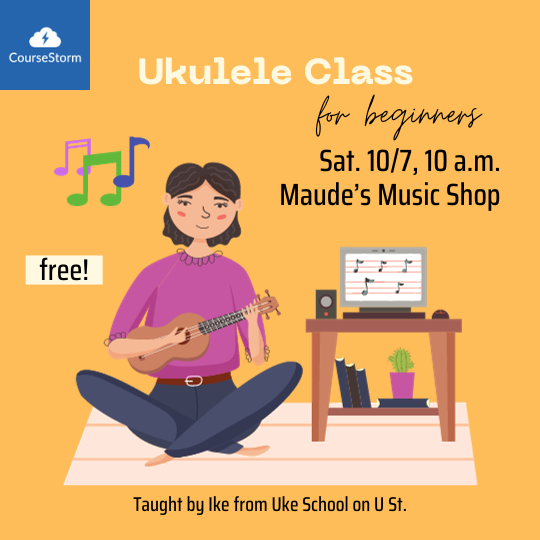
Who Benefits From a Local Business Partnership?
With a well-designed local business partnership, everyone benefits. You expand your audience by tapping into the business’ client base. The business gets greater visibility with your students. Meanwhile students and customers get a class or experience that neither organization could have provided alone.
By building relationships in your community, you create a more supportive environment for everyone.
From a wider perspective, the local economy benefits because students spend their money with local organizations and businesses. By strengthening relationships in your community, you build a more supportive environment for everyone. These may sound like grand claims, but everyone benefits from a more-connected community.
How to Choose the Right Local Business Partner
Your goal in choosing a local business partner is to find a business with customers who match your ideal student audience. Look around at small businesses in your area and think about what their customers might be interested in learning.
For example, you might offer:
- Writing classes at a bookstore
- Movie appreciation class at a local movie theater
- Wilderness survival courses at a campground
- Business classes hosted at a local business
- Parenting or child development classes at a toy store
- Textile arts classes at a local clothing boutique
- Music lessons at a music store or record shop
- Flower-arranging class at a home decor store
The class you offer doesn’t have to overtly connect to the product or service the business provides. Instead, look for a match in mission. For example, your local vintage clothing store may be excited about the idea of sustainability. Maybe they’d be willing to host a class on recycling, sustainable living, or the environment.
Your potential local business partner might also have some ideas. Ask them what they think might interest their customers and look for ways to help make those classes possible.
Sell the Idea to a Local Business Partner
Some local businesses will immediately recognize the benefits of partnering with you. Others may need some convincing. You can help them make an informed decision by offering essential information in a useful way. Follow these guidelines to start building your partnership.
Explain how the business could benefit: e.g., “If you hosted a class in your cafe, I’m sure students would buy coffee while they’re here.”
- Be clear and specific in your request. Instead of: “Would you be willing to host a class for us?” Say: “Do you think your customers would be excited to take a music appreciation class right here in the music shop?”
- Explain how the business could benefit from the partnership. For example, “If you hosted a class in the cafe, I’m sure students would buy coffee and snacks from you while they’re here. They might even come back at other times throughout the week.”
- Give them time to think. It might seem easiest to just walk in and talk to someone during business hours, but that also puts that person on the spot. They might be busy serving customers, or the owner might not be there that day. If you visit in person, bring a written letter or follow-up with an email that outlines your idea.
Networking events are a great place to find local business partners. The people at these events are likely to be open to new business opportunities, and you can talk to them without interrupting their workday. Check out your local Chamber of Commerce or look for community business networking events on Facebook to find networking events in your area.
Strategies to Make the Most of Your Partnership
Whether you’ve set up a guest speaker arrangement, venue partnership, or community sponsorship you’ll need to work together to achieve the best results. Here are some strategies to help you make the most of your partnership:
- Get aligned on goals. Talk about what each organization hopes to accomplish so you can help each other reach your goals.
- Clearly outline expectations for each partner. Have a meeting where you outline each group’s responsibilities and a timeline for achieving them. Who will handle course content, materials, setup and cleanup, marketing, etc.
- Cross-post on social media. Ideally, both organizations will post about the upcoming class on social media. If you create a Facebook event for the class, make sure your partner is set up as a co-host. Share the registration link and any other details they need.
- Mirror your marketing messages. Use the same course description and registration link across all of your marketing materials. If each organization creates its own marketing messages, you might end up confusing audiences.
- Reach both audiences. Both your organization and the partner business should market to their own audience through email, social media, signage, and their websites. Each of you should promote with the same energy you bring to your own programs and events.
By now, we hope you’re ready to start looking for local business partners for your community classes. If you need some inspiration, maybe these unusual course offering ideas will help get your thoughts flowing in the right direction.
-
Creative Aging: Why Arts Educators Need to Engage Older Learners Now
You’re never too old to learn something new, and it’s never too late to embrace your creativity. That’s the idea behind creative aging: art programs for older adults that enhance their quality of life through music, visual arts, and other activities.
If you’re an arts organization, library, community center, or anyone offering educational programs to the community and you are not serving older adult learners, you’re missing a huge opportunity.
By 2030, older adults (aged 55+) will be the dominant age demographic in the United States. By 2034, older adults will outnumber children under age 18 for the first time in U.S. history, according to Census Bureau projections.
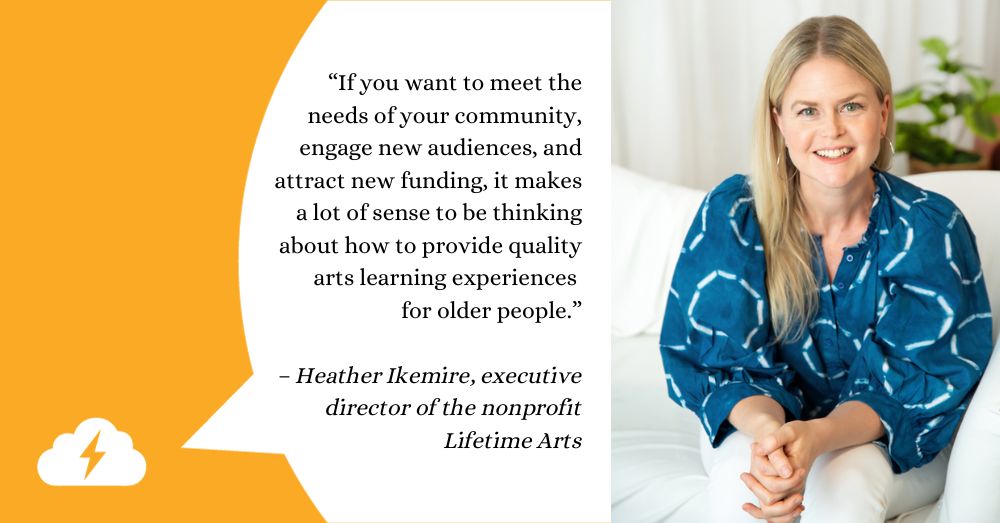
“If you want to meet the needs of your community, if you want to engage new audiences and attract new funding, it makes a lot of sense to be thinking about how to provide quality arts learning experiences for older people,” said Heather Ikemire, executive director of the nonprofit arts service organization Lifetime Arts.
But first, there are a few things you should know about reaching an audience of older learners.
What Is Creative Aging?
In case you haven’t heard it before, the term “creative aging” describes the use of arts and cultural activities to improve the quality of life for older people, Ikemire explained. The field encompasses many different approaches and is practiced all over the world. Lifetime Arts recently hosted the 2023 International Creative Aging Summit, which had 400 participants from 26 countries.
“While the approaches to the work vary, in its broadest sense it’s recognizing the power of creative expression—engaging older people in activities centered on creative and social engagement, and the power that has in terms of supporting quality of life, the process of aging well, and also transforming cultural mindsets around what it means to age,” said Ikemire.
Creative aging programming can happen in multiple disciplines (music, film, visual art), in multiple spaces (libraries, museums, senior centers), and remotely or in person.
Creative aging programming can happen in multiple disciplines, including music, film, theater, and visual arts, and in multiple spaces, such as libraries, museums, veterans homes, and more. Classes for older adults can happen remotely as well as in person, and can be free, paid, or subsidized programs.
Key Characteristics of Older Adult Learners
Older people are living longer and seeking meaningful ways to connect and continue to learn skills. But a watercolor class for adults aged 55+ should not be identical to a class for school-aged students. There are several factors that differentiate older learners from their younger counterparts:
Adult learners are autonomous and self-directed. “They vote with their feet,” as Ikemire put it. Educational programming has to speak to them and their interests or they’ll go find something else. The best way to offer programs they want? Ask them! “It’s incredibly important to listen to the older adults in your community,” Ikemire advises arts organizations.
Older people are goal-oriented. They’re not just looking for a hobby or something to fill the time. They want to learn and develop skills. The creative aging model used by Lifetime Arts focuses on professionally led instructional arts programming designed to build artistic skills over time. Participants have an opportunity to practice something and then keep applying it so they can see their skills improve.
They are seeking connection. There’s a reason creative arts programming typically takes place over a period of many weeks rather than one-time drop-in sessions. “There is evidence that shows that building social connection over time can actually lead to significant physical and mental health benefits for older people,” said Ikemire. Art classes for the elderly help to reduce social isolation and loneliness, among other advantages.
In a recent survey, 42% of U.S. adults aged 55+ said they were seeking more social connection in their lives.
A recent report on aging surveyed more than 28,000 U.S. adults aged 55+ and found that 42% said they were seeking more social connection in their lives. That percentage increased with age.
They may have barriers to participation. These may include physical limitations, such as hearing or vision impairments or an inability to stand for long periods. Transportation could be an issue, or time of day if they don’t drive at night. Or, there might be another popular class in the community that meets at the same time as yours.
Seniors are not necessarily tech-averse. If you’re offering an online class, or even online registration for an in-person class, you might assume that rules out older learners. That’s not necessarily the case. While some seniors may be unfamiliar with technology, many are more tech-savvy than ever, thanks to the pandemic. That said, there are some best practices for working with seniors that we cover in our post, 6 Tips for Teaching Tech to Older Learners.
Opportunities for New Revenue Streams
Offering arts programs for seniors not only benefits older learners in a community, but also can boost the bottom lines of the education programs. “It can be a really wonderful earned revenue stream for some organizations,” said Ikemire.
Many arts centers, museums, and theaters are empty during the day. This is especially true for an arts organization that has primarily been serving younger people with weekend classes and afterschool programs. Welcoming older learners into your space during daytime hours is a good way to bring in new audiences.
“When you see creative arts programming in action, it’s joyful. It’s incredibly powerful.” – Ikemire
Ultimately, these programs thrive when there’s institutional buy-in. A big part of making that happen is seeing these programs in action. Invite your staff, your board members, or other stakeholders to see creative arts programming in action.
“When you see it, it’s joyful. You get it right away. It’s incredibly powerful,” said Ikemire. “And there are incredible opportunities to grow audiences, to increase your budget, to find the funders for your work, and also to spark intergenerational connections between young people and older people.”
Examples of Successful Creative Aging Programs
When done right, arts programming for seniors can boost revenue and student loyalty. Here are a couple examples of successful programs for older learners.
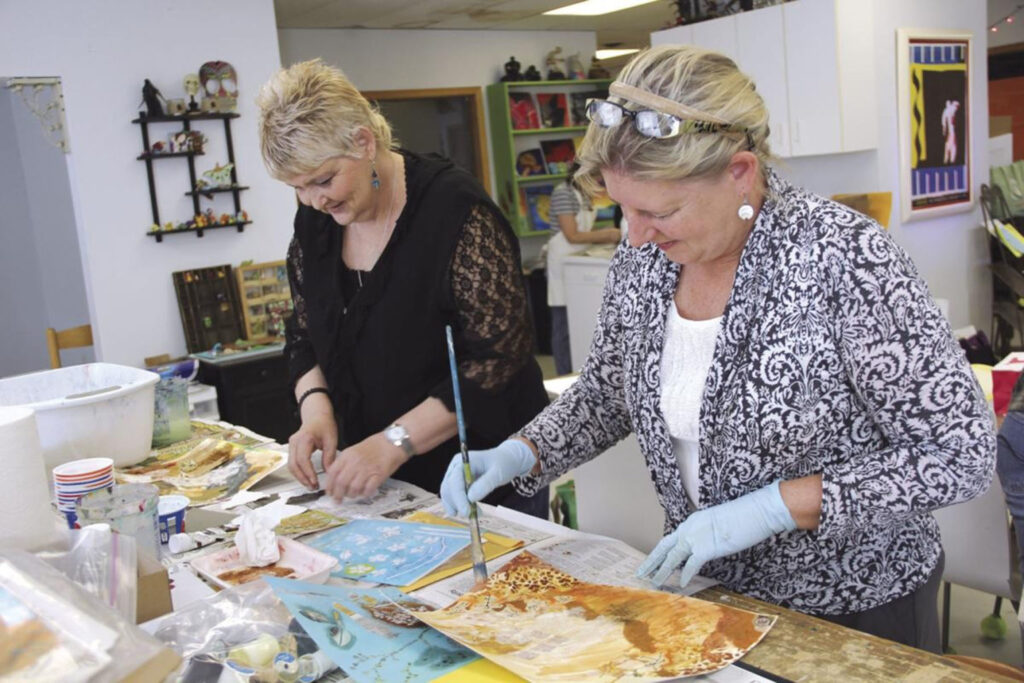
Rumriver Art Center, Anoka, MN. Photo credit: Larry Weinberg
Rumriver Art Center
Previously only providing youth classes, Rumriver Art Center in Minnesota decided to expand their program offerings to include arts education opportunities for adults 55+. These programs attracted so much interest that they had to add more classes and staff.
Over the course of two years, the center’s creative aging programming budget increased from zero to over 25% of their annual budget. Many of the students later became teachers, volunteers, and even employees after attending classes.
Forever Learning Institute
Another example of a thriving education program dedicated solely to older adults is the Forever Learning Institute (FLI) in South Bend, Indiana. For 45 years, FLI has engaged older learners through a robust catalog of enrichment classes covering all sorts of topics including dance, technology, literature, and foreign languages. The classes are taught by an all-volunteer faculty.
FLI is home to the Silvertones, a musical glee club for ages 50+, that performs at various community locations throughout the year, as well as the Solid Silver Dancers, who learn and perform dances from the 40s, 50s, 60s, disco, Broadway, and more. The course description for that class describes it as “a dance workout that is easy on the knees and made especially for us seniors. But still fun and sassy!”
It’s worth noting that courses that incorporate movement are especially important for older learners. Numerous medical studies have shown that the more physically active you are as you age, the healthier you’ll be for longer.
Creative Aging Resources for Arts Organizations
There are numerous resources for organizations interested in learning about and implementing creative aging programming, many of them free. The best place to start is Lifetime Arts’ website, The Creative Aging Resource. The site includes articles, case studies, presentations, and research on a wide range of topics related to arts education for older populations.
Lifetime Arts also offers Creative Aging Foundations On Demand, a free, self-paced online course designed for institutions and individuals seeking to run arts programming for older adults. The course includes instructional videos, practical program design principles, and information on developing partnerships with other community organizations serving older adults.
“Creativity is a human right for all of us throughout our lifespans.” – Ikemire
“This is a time for us as mission-driven organizations to think about how we can provide programming that can really enable all people, including older adults, to age well, to age in community, and to still contribute,” said Ikemire. “Creativity is a human right for all of us throughout our lifespans.”
CourseStorm counts a number of community education and arts organizations among our customers. Our mission is to streamline access to education to empower personal growth. Learn more about us and get in touch today to see how we can help your organization.
-
6 Easy SEO Tricks to Make Course Listings More Visible on Google
The secret to search engine optimization is that there is no secret. But a few easy SEO tricks can make your course listings more visible on Google. Not only will they help students find your course pages, they’ll also make those pages more user friendly and attractive for learners.
You might be wondering why we’re focusing on Google specifically. The answer is pretty simple — Google searches account for more than 85% of the global search market share. Optimizing for Google search is a high-impact way to increase the visibility of your courses across the internet.
We’re not going to tell you to hire a pricey SEO firm or rebuild your entire website from scratch. Instead, we offer real changes you can make today to improve your SEO performance. Because when it comes to search engine optimization, small changes can make a big difference.
What Is Search Engine Optimization?
Let’s start by defining our terms. Search engine optimization is the content, formatting, programming, and hosting decisions that help you show up first in search engine results.
For the purposes of this guide, we’re going to talk mostly about on-page SEO. That is, the changes you can make to content on individual pages of your website to improve your ranking. We’re not going to get into programming and web development. Although, if you really want to up your SEO game, your web developer probably has some suggestions.
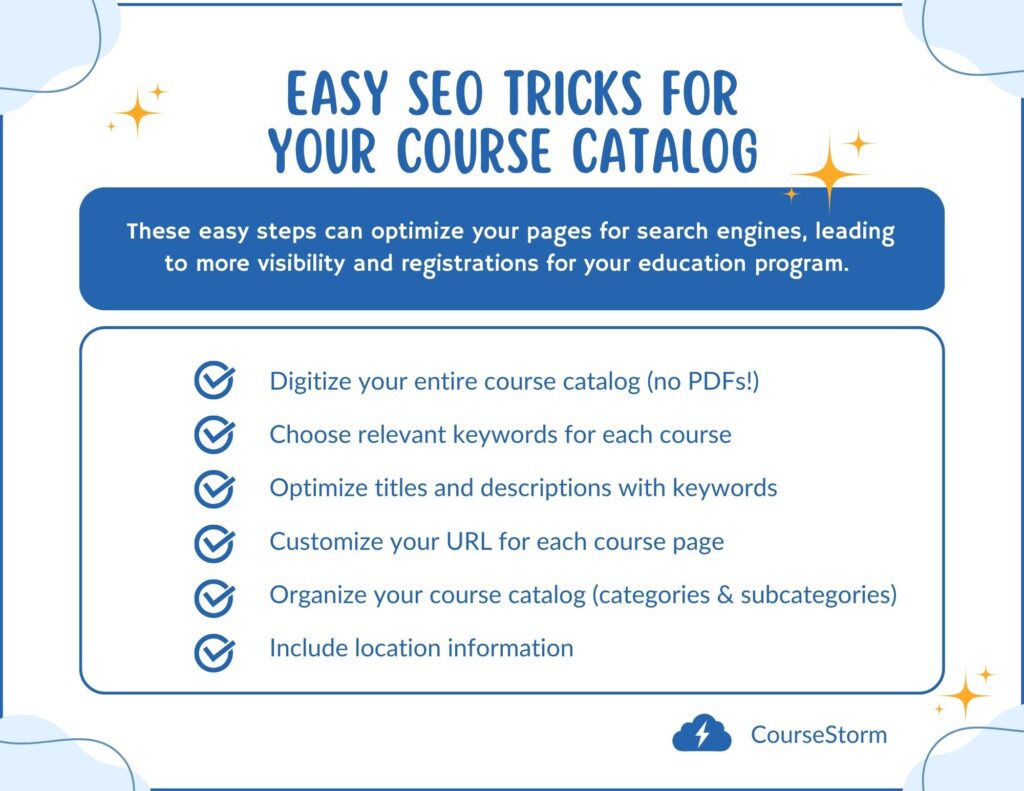
Easy SEO Tricks to Quickly Make Course Listings More Visible
These easy SEO tricks can apply to any page on your website, but we’re talking about how they can help with course listings because increased course page visibility often leads to more registrations for your program.
1. Digitize Your Entire Course Guide
Printed course guides are still a powerful tool. Sending them directly to potential students can help interest them in your programs, but a print catalog can’t improve your SEO. Some programs try to get away with uploading their course catalog as a PDF on their website, but that won’t help either.
Uploading your course catalog as a PDF does not help SEO since search engines can’t read the contents of PDF files.
First, search engines can’t read the contents of PDF files. When your course catalog is a PDF, you miss multiple opportunities to rank in search for course types and individual classes. Second, it creates an accessibility barrier. Some people are anxious about downloading files that could potentially infect their computers. Others don’t have the bandwidth for big downloads.
Worse, if someone is visually impaired, their assistive tools may not be able to read all PDFs.
When people can’t read your content, they’ll spend less time on your site, which means Google will assume you were unable to meet the user’s needs. The search engine will be less likely to show your content in future searches.
So, putting your course catalog online is good for potential students and for SEO. Without this step, none of our other easy SEO tricks really matter.
2. Choose Keywords That Fit Each Course
Keywords are a core element of search engine optimization. Search engines look for keywords to tell them what a page is about. If the keywords on your page match the ones a potential student typed into their search engine, you’re more likely to rank. Keep in mind that the most powerful keywords aren’t individual words at all. They’re keyphrases. For the blog post you’re reading now the phrase “easy SEO tricks” was one of our keywords.
The most powerful keywords aren’t individual words, they’re keyphrases. Aim for at least 3 per page.
For each page of your course guide, you should have a minimum of around three keywords. One, the primary keyword, should tell visitors the topic of your course. You can mix in a few secondary keywords to add context.
For example, if your keyword is “Beginners Acting Class for Kids,” you might include phrases like:
- Drama class
- Acting training
- After-school activities
- Improve public speaking
You can use Google Trends or other keyword research tools to find the right words.
3. Optimize Titles and Descriptions
The most powerful place to include keywords is in your title. Let’s say you have a course that helps behavioral health professionals get certified. Your title should probably include phrases like Behavioral Health Professional Certification Training or Certification Training for Behavioral Health Professionals.
Your secondary keywords can show up in your description. Don’t get carried away here. In the early days of SEO, the more you used a keyword, the better you ranked. Now, it’s all about context.
Your course description should be interesting and informative. Any keywords it uses should be grammatically correct and make sense in context. They should help the visitor understand what the class is about and whether it’s the right choice for them.
4. Customize Your URL for Each Course Listing
This is an easy SEO trick that many people miss. Every page in your course guide has a unique web address. It probably looks something like this: https://coursestorm.yourprogram.org/course/name-of-course/
Make sure that the slug, or URL, for each course page contains your keywords.
The part we’re interested in for SEO purposes is the text between the last two backslashes. This is known as the slug, and it’s a unique identifier for your page. You want to make sure that the slug includes the keywords for your course. So, if you have a course on How to Draw Animals your slug should be something like /how-to-draw-animals/.
Here’s what to avoid when choosing a slug:
- Don’t use an internal course number. /290340u57/ might make sense to you, but it doesn’t tell Google anything about your course
- Keep it short. /how-to-draw-cats-dogs-chickens-pigs-with-artist-sarah-smith/ is too much and misses the keyphrase
- Use real words and recognizable phrases, i.e. don’t shorten how to draw animals to /hw-to-drw-anmls/
Most website content management software includes an option to customize your slug. Take the extra moment to do this and you’ll instantly improve SEO.
5. Organize Your Course Catalog in a Meaningful Way
Google doesn’t just look at individual pages. It also considers how those pages fit together. This is another case where improving SEO also improves the user experience. When you organize your course content in logical ways, both Google and your potential learners can easily find what they’re looking for.
Organize your course guide into logical categories and subcategories. Categories might include broad topics like:
- Career Development
- Personal Enrichment
- Business and Skills Training
- High School Completion
- Technology
- Summer Camps
- Health and Fitness
Subcategories are more focused but still encompass multiple classes. So under Personal Enrichment you may have subcategories like:
- Arts and Crafts
- Cooking
- Outdoor Experiences
- Personal Finance
Try to choose categories and subcategories that your average student (or their parent) might search for.
6. Include Location Information
Mentioning the city and state where your class is located can make your listing more likely to rank for “near me” searches. So if someone types in “personal finance classes near me” your course listing is more likely to pop up in their search.
Skip this step, and you could be left off the list. It’s probably not enough to include the location of your organization on the contact us page. Make sure it appears on every course listing.
Think Beyond Easy SEO Tricks to Keep Improving
The easy SEO tricks we’ve shared here will get you started. They’re a quick way to improve user experience and get seen on Google. But they’re just the beginning. Keep in mind that SEO is always evolving. What works now may not be a best practice in three years. Watch the headlines to make sure you never miss an update.
CourseStorm can help you create a user-friendly, search engine optimized course catalog.
Our simple course registration software helps you stay organized, lets you customize your URL, and features location information for every class. For more tips on reaching more students, read our post on course catalog examples that boost enrollment.
-
9 Key Elements of a Course Catalog: Examples That Boost Enrollment
Building a quality course catalog can help you convince more students to register. The most effective course listings are more than a simple list. They combine all of the information students need to know to make an informed decision about your courses.
We see a lot of course guides in our work with community and arts education programs. Among the hundreds we’ve seen, a few stand out as strong course catalog examples that other programs could emulate. You can use these examples as a model as you build your own course listings and to avoid common pitfalls. We’ll even break down each one so you can see what makes them effective.
What Is a Course Catalog for?
You may think that a course catalog is a list of classes offered by your program or organization. What people sometimes forget is that a quality course catalog is also a marketing tool. Students use it to decide which classes to take and whether those classes are worth their time and money.
To be effective, your course catalog must capture the eye and the imagination of your potential students. It needs to convince them to register right now.
Potential students who browse a course catalog are looking for answers to two important questions:
- What will this class teach me?
- Is the value of this class worth my investment of time and money?
Many programs struggle because they stop after answering question one. They tell students about subject matter and learning outcomes, but fail to explain why those outcomes matter. As a result, students know what the class is about, but may not see the true value in the experience.
An effective course catalog convinces students of the value of each class. It uses every course title, description, and image to show students what they can get by taking the course.
9 Parts of an Effective Course Catalog, With Examples
An effective course catalog includes 9 parts. Each one helps the student gather information about the courses offered.
- Categories
- Subcategories
- Class names
- Class descriptions
- Images
- Instructor information
- Place and time
- Pricing
- Registration link
Below, the course catalog example from San Juan College Community Enrichment shows all 9 parts in action.
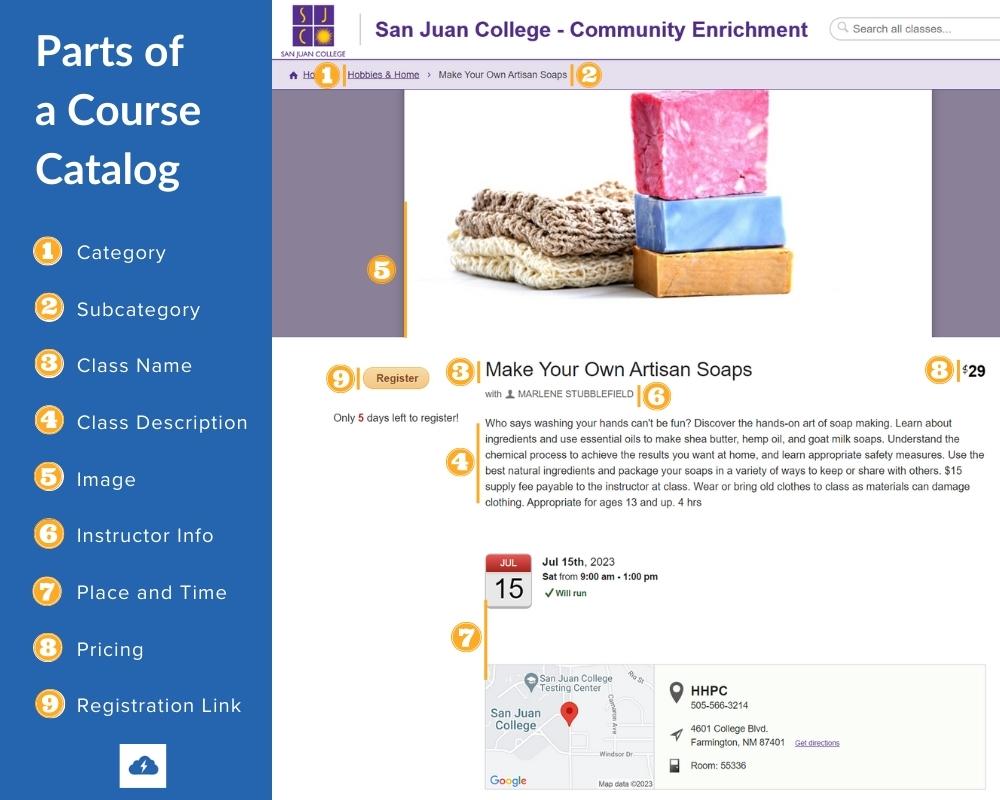
1. Categories: What Is This Course About?
Categories help to group similar kinds of classes and make it easy for people to find the classes they’re looking for. Seek a balance between overly generic and too specific. The goal is to logically group clusters of related classes.
Some categories that are broad, yet specific enough to be useful may include:
- Kids classes
- Workforce development
- Fitness
- Finance
- Music and dance
- Arts and crafts
- Computer skills
- Cooking
For example, the category “Cooking” is precise. Someone can easily imagine the kinds of classes that might fit into that category. It’s also broad enough to include several different classes. Something like “French Cuisine” may be too specific, unless you run a cooking school.
2. Subcategories Make Navigation Easier
Subcategories can break down big topics into more specific focus areas. This helps students find the classes they are looking for by guiding them through your course catalog.
For example, you may have 30 classes in workforce development that focus on 5 or 6 subtopics. Categories can help students find the courses that are most relevant to them.
Some example subcategories for workforce development might be:
- Computers & technology
- Healthcare & medical
- Entrepreneurship
- Financial literacy
- Skilled trades
3. Class Names Tell Students What to Expect
Effective class names tell students what the class is about. When writing class names, aim for clear description over cleverness. Here are a few examples of real class names that work:
- Digital Photography: Capturing the Right Shot
- Write From the Heart for Fun and Profit
- Five Unexpected Books Every Classical Educator Should Read: Free Webinar
- Websites That Work: Converting Web Visitors Into Customers
These class names work because they’re clear and include keywords that search engines can find. Some also include extra details about format or cost.
Of course, if you can be clear and clever, that’s even better. One CourseStorm customer put this idea into action for her “Learn to Crochet” class. Last year, the class was canceled due to lack of registrations. Instead of overhauling the class, she changed the name. This year, she quickly filled the class “Too Legit to Knit: Crochet Instead.”
Pro Tip: If you run the same class every season, keep the name the same in each version of the catalog. (Unless you’re hoping to revitalize a lagging class!) This helps students recognize classes they’ve already taken and spot new ones on their preferred topics.
4. Descriptions With Real Course Catalog Examples
Course descriptions tell students what they’ll learn and why they should take a course. Focus on the real effect the course could have on their life. Writing a quality course description takes some effort, but the results are worth it.
Here’s an example of a real course description from The Training Place:
“If there’s one thing guaranteed in life, it is change. The way in which we navigate unanticipated change and stressful experiences will have a direct impact on our mind and body in subtle and not so subtle ways.
You will be introduced to the Change RHYTHM model, explore the tone of your inner narrative, self-assess your relationship and mindset towards a recent change event, and define a set of unique resilience rituals that will enable you to adapt to and evolve through the change and maintain forward momentum in the new normal that follows.”
This course description works because it:
- Speaks to a real need the student has — dealing with change.
- Explains exactly what students will learn.
- Includes a clear outcome: “adapt to and evolve through the change and maintain forward momentum in the new normal that follows.”
Pro Tip: If you realize you need to share more information than can comfortably fit in a course description, consider linking to a course fact sheet or FAQ attachment.
Keywords: the Hidden Element of a Course Catalog
Using key search terms in your course titles and descriptions makes them more discoverable to search engines. That helps your students find what they’re looking for.
You can do some basic keyword research using a tool like Semrush or Moz. Then, include those keywords in your course descriptions. Aim for a good mix of the two main types of keywords:
- short-tail keywords are short and broad, such as “classes for adults” or “First Aid class”
- long-tail keywords are longer and more specific, like “sustainable papermaking course for adults” or “Lego robot workshop for teens”
Include both so search engines can see what your course is really about and who it’s for.
5. Images Increase Engagement
Images make your course listings seem more inviting. The best option is to use real photos from your courses. If that’s not possible, high-quality stock images or custom graphics can fill the gap.
Look for images that are easy to understand at a glance. Smiling faces and bright colors tend to be most engaging. Remember to use images that include all the types of people who might take your classes.
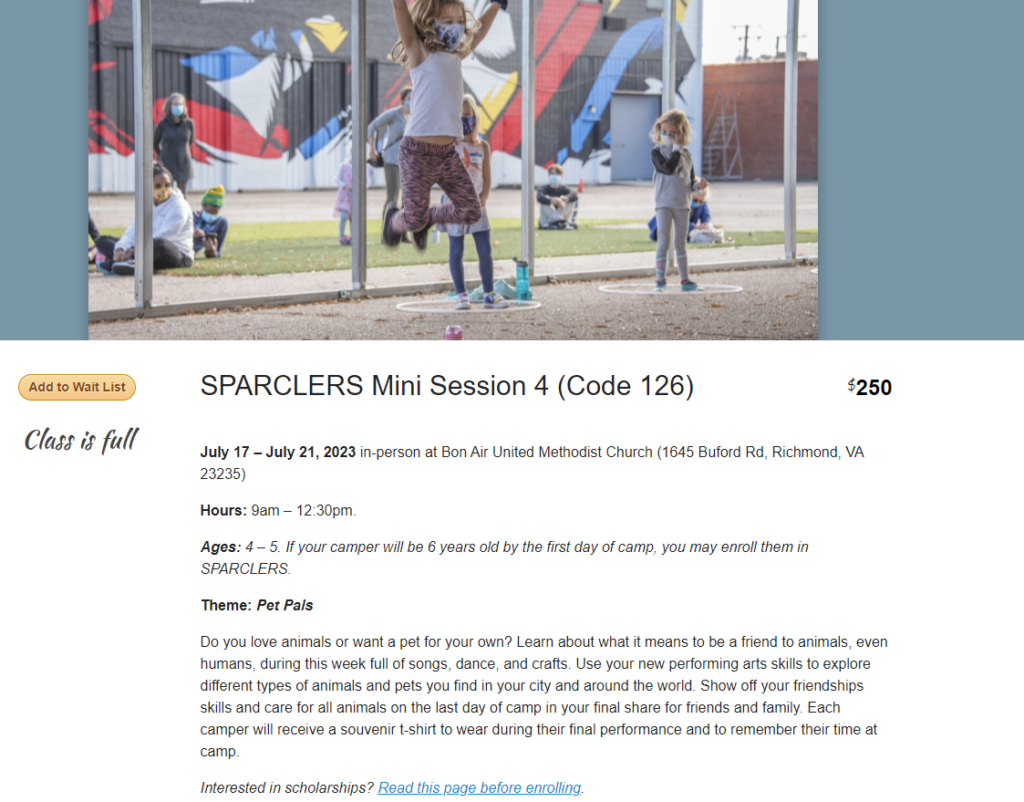
6. Instructor Information Boosts Student Confidence
Information about the instructor can provide a compelling reason to take a class. Include a paragraph about the instructor and their background, or link to their bio elsewhere on your site.
7. Place and Time Help Orient Students
Include information about when and where the class will run, so students can tell if it fits their schedule. Remember to mention whether a class is online or in-person.
8. Pricing Information Is Essential
Include clear pricing information for every class. Make sure you’re accurately portraying the whole cost of the program. Some students may love to take an art class for $300, but when they find out they have to spend another $300 to buy their own supplies, the course no longer fits their budget. It will save both your time and theirs to be forthright about pricing.
For big-ticket courses, consider offering payment plans to make them more accessible. Being open about pricing helps build trust and gives students the information they need to make an informed decision.
9. Registration Links Let Students Act Now
Every class listing should include a button or link where students can register right away. This makes it easy for someone to act while interest is high.
Using online registration software with payment processing streamlines enrollment for students and for you. After registering online, all they have left to do is show up for class!
Avoid This Major Course Catalog Mistake!
Some programs can get all 9 parts right and still not see the number of registrations they were hoping for. Why? Because they’re requiring an account before letting someone view their course catalog.
We’ve all had the experience of trying to read an online article only to be informed that we need to create an account first. Not only does this interrupt the natural flow for the user, but it also makes them mistrustful. They wonder, “Do you even want me to read your content, or do you just want my contact information so you can bombard my inbox with sales emails?”
Your class offerings aren’t confidential information—in fact, the more people who know about them, the better! Making your course catalog accessible to all gives students the chance to discover a class that’s a perfect fit for them.
Quick fix: Share your course catalog openly and freely. Make sure the link routes visitors directly to the catalog without a login.
Course Catalog Examples: How It All Fits Together
A well-organized course catalog is inviting. Whatever organizational structure you choose to guide your layout should be consistent throughout. For example, you may choose to list your classes alphabetically, or you may choose to list them based on when they run, or you may choose to list them by type category.
However you organize, make sure the course catalog is searchable. Bonus points if you can allow students to adjust how courses are sorted so they can view them by date, price, or alphabetically by title.
CourseStorm offers everything you need to build your own course catalog like the examples shared here. To learn more, start your free trial or contact us today.
-
Low-Cost Course Promotion: How to Advertise a Class on a Budget
When you think about how to advertise a class, paid ads might be the first idea that comes to mind. That makes sense, since paid advertising absolutely can help with course promotion. There’s just one major drawback to this strategy—the cost.
Most education programs don’t have massive budgets to work with. They need affordable, maybe even free, ways to promote classes. Fortunately, it is possible to advertise courses without spending a ton of money. To help you do that, we’re sharing some of the ideas we’ve seen CourseStorm customers use to promote their classes and programs.
Course Promotion Starts With a Clear Message
You’ll use the same basic information in many different ways to advertise your course. So the first step is to collect all of that information. You’ll want a clear and compelling course description, some relevant images, and a link that people can use to sign up. All of this should be easily found in your course catalog.
Set up an easy website link
The benefits of straightforward website navigation can’t be overstated! When folks visit your website, make sure it’s easy to find your newest courses.
Don’t assume interested students will dig through an entire course catalog to find the class they’re interested in. Make sure the link you share on social media or other third-party sites brings the user directly to the sign-up page for that specific course.
With this information in hand, you’re ready to start advertising your course.
Ways to Advertise Courses for Free
1. Send an announcement to your email list
The first step is to prepare an email blast to send to your contacts. Announcing the new class to your existing customers first is good practice, because these are most likely to be people who have taken your courses before.
Include the course description and a registration link. You can also mention that you’re sharing the news with your email list first. People love to feel special and in the know, so an exclusive first look at upcoming courses can help build student loyalty.
Keep in mind that people get a lot of emails. You might want to send the announcement a couple of times over two or three weeks to make sure it gets seen. If you send multiple emails, use different subject lines for each one. You can also personalize email content and subject lines to make messages more appealing.
2. Share on social media
Create an eye-catching social media post to share the news about an upcoming class. If you’re sharing on Facebook or LinkedIn, you can share the link with a short description, and the platform will automatically include your image.
For Instagram, you’ll need to get a little more creative with your social media graphic since you can’t share links directly. Include a link to the course in your bio or as part of your Linktree. Don’t forget to mention the link in your post. See the example below for one way to do that.
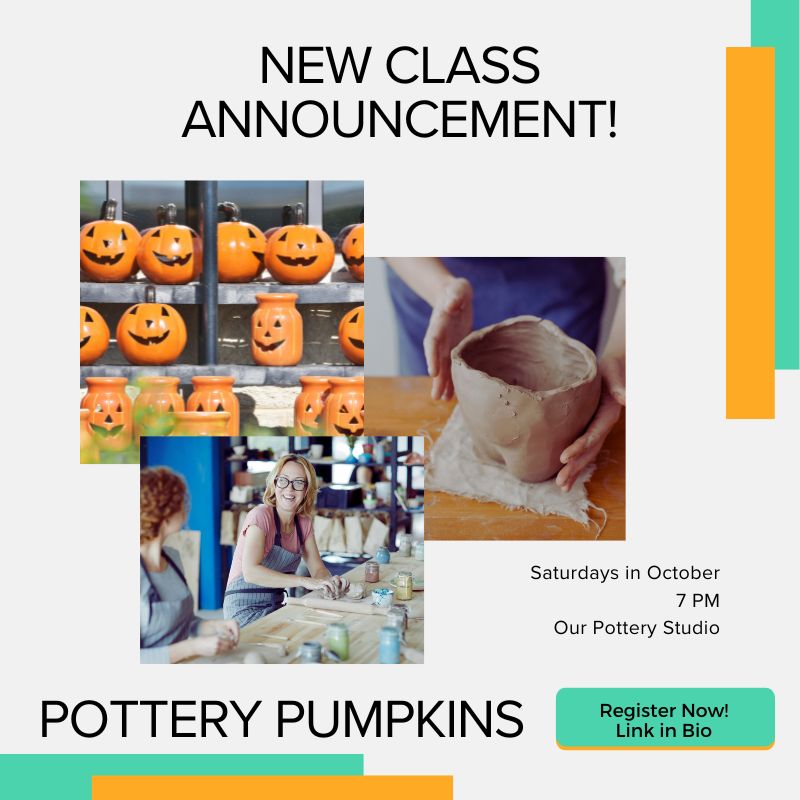
In fact, wherever you post, include a call to action. A call to action is a short, specific statement telling users what action to take when they view your content. Examples of call-to-action statements include:
- Register Now
- Save Your Seat
- Sign Up
- View New Classes
Encourage your staff to share the post on their personal social media pages as well to boost your views. If you’re into social media advertising, you can also “boost” it as a sponsored post.
3. Add a link to your email signature with a call to action
It’s easy to overlook the not-so-humble email signature! They’re relatively easy to change and that makes them an excellent place to share major announcements.
If you’re announcing a new class, edit your email signature to include a button, graphic, or link to the registration page. You can ask everyone in your organization to share the link in their emails as well.
4. Use your voicemail message to alert your audience
Most voicemail programs are easy to update, so big news can be shared in that space too. Be concise and direct listeners to a place they can learn more.
For example, “Registration for our new Adult Dance classes is open now. Visit our website to save your spot.”
5. Get it on a local events calendar
Most local and even regional news outlets have community calendars where you can share your class information. They might be called briefs, upcoming events, or community news. Members of the community can submit short listings for events, workshops, or classes.
Check your local paper or publication to see if they have something like this. If they do, make sure you follow their directions for how to post. Some will ask you to send an email to a specific address. Others offer the option to automatically add your listing using a simple submission form. It’s a quick and easy way to make your classes more visible.
6. Create a Facebook event
Many people use Facebook as a tool to find out what’s going on in their community. Create a Facebook event to get in front of this audience. Make sure you clearly state that registration is required and what the class costs.
Include all of the location and scheduling information. Then link to your registration page so people know how to sign up.

7. Send a press release to appropriate media channels
A press release can help your program spread the news quickly. Write your class announcement following standard press release format, and email it to your media contacts.
If you don’t know anyone at the local news station, visit their website. They should have a page that tells you where and how to submit news. Your local chamber of commerce may also be able to provide you with a media contact list.
If you don’t hear back within a few days, you can send an email to follow up. Keep your email short and polite. Something like this:
Dear Editor’s Name,
I know you get a lot of press releases and there’s a chance mine got lost in the shuffle. We’re offering a new class that can help adults prepare for in-demand tech jobs. It’s a timely topic since the tech job market is growing rapidly. I’ve included the release again below so you don’t have to go digging for it.
Best,
Your NameKeep in mind that making staff and instructors available as sources, and generally being helpful to the press is a long-term investment. When editors and journalists see that you’re a reliable source who provides newsworthy information, they’re more likely to work with you. Keep building these relationships to get your classes the publicity they deserve.
8. Host a live stream
People love live videos! You can share your news with a live video on your favorite social media channel. Don’t overthink it. Here’s an easy recipe for a successful live experience:
- Announce it a few days ahead of time
- Plan for no more than 15 minutes
- Prepare a list of talking points
- Practice beforehand
- Go live!
As an example, here’s how to start a live broadcast on Instagram.
How to Advertise a Class Inexpensively
9. Drop it in the mailbox
If you have mailing addresses for prior students, you can drop a postcard in the mail to announce your new class. Physical mail stands out because it’s less commonly used these days. That means students may be more likely to pay attention to this tactic if it’s used sparingly.
You can target your list by deciding to send it to the people you think will benefit the most. That could be only people who registered in the past year or only those who pay with cash or a check.
The US Postal Service also provides special rates for bulk marketing mail that will allow you to target residents in a particular zip code. They even have discounted rates if your organization is a nonprofit.
Good design is really important for physical mailings. You want people to really look at your postcard, not lump it in with junk mail. Make sure to include a short website link where they can access more information. You might also include a QR code (more on those in a moment).
10. Put up posters using easy-to-access QR codes
Posters are still a great way to announce upcoming classes. They target a local audience and can reach people who aren’t already on your mailing list or following you on social media.
To make it easy for folks on the move to find out more, use a custom QR code that can be scanned with a cellphone camera to share specific information. You can make them for free using an online generator. We like Unitag but Canva also has a built-in QR code app you can access if you’re already using this graphic design software to make posters.
11. Increase engagement with a promo code or discount
A promo code can entice someone to read more or take a chance on a new class. The discount can be limited to meet a specific timeframe, like the first week after the class is announced. Send it out to your email list or print it on your postcard mailing.
You might even offer discount codes as a reward for signing up. Students who register for your new class can get a code that they can use for future classes or share with a friend.
Download the Class Promotion Checklist
Every time you have a new class to promote, you can follow this list. If you can supplement with some paid advertising, great. If not, these tactics should still help fill your classes.
Want a handy checklist version? We created a printable, easy-to-use reference to make remembering where to share even easier for you.
Of course, figuring out how to advertise a class is just the first step. Next you need to make it simple for students to register. That’s where we come in. CourseStorm’s simple online registration and payment solution offers a streamlined class sign-up process for every student.
-
The Benefits of After-School Enrichment Programs
Students are heading back to school. And that means parents are looking for activities to keep their children busy and engaged after the dismissal bell rings. That may be aftercare or afterschool enrichment programs at school or other enrichment activities in the community.
A national survey of 2,000+ K-8 parents and guardians by the nonprofit organization Learning Heroes found that 65% have children enrolled in after-school activities. The most common reason was “to expose children to new experiences, ideas, and perspectives beyond their everyday home and school lives.” Data also show that demand for afterschool enrichment programs has skyrocketed.
This article can help organizations offering afterschool enrichment programs to understand what parents and students are looking for in after school enrichment activities, showcase the benefits of your program, and attract and enroll more students.
What Are Enrichment Programs?
After-school enrichment programs typically focus on fun, games, play, movement, and other activities students may not get to participate in during the school day.
Afterschool enrichment programs typically offer a variety of activities, letting students explore and discover new interests.
Afterschool enrichment programs often provide a range of activities, letting students explore different options and discover new interests. “Furthermore, because after-school programs are sometimes more diverse than school classrooms, with students of different ages and backgrounds, children can build empathy, communication and teamwork skills,” noted US News & World Report.

In fact, building those “soft skills” that are so important in the workplace and in life is one of the key benefits of enrichment programs for all ages.
There are after-school enrichment programs specifically focused on subjects like coding or the arts, such as TRYPS Children’s Theater in Missouri, which offers an arts-based alternative to other afterschool programs for grades K-5. Students participate in “mini plays” and theater games as well as art projects and field trips.
Most after-school enrichment programs are geared toward elementary-age students. However, there are opportunities for middle school and high school students as well. Activities for these ages tend to take the form of afterschool clubs like chess, robotics, or coding. Some community makerspaces may offer enrichment classes or workshops. For older teens, afterschool workforce development programs are an option. And of course, sports and music are always popular after-school activities.
The Top Afterschool Enrichment Classes for Kids
The Learning Heroes report found that 49% of after-school activities are arts, sports, or interest-based programs, and 18% are academic. As for the most popular after-school enrichment activities, US News puts these at the top of the list:
Art. “Art is fundamental to education as a cross-brain experience that involves mind, body, and heart,” said Karen Pittman, co-founder of the nonprofit Forum for Youth Investment. Read more about the positive impact of the arts on health, as well as how to market art classes for kids to the parents who will register them.
Foreign languages. Research shows that language learning is linked to higher academic achievement and can help develop students’ reading abilities. Learning a second language has other benefits, as well. Bilingual children have been shown to demonstrate empathy better than their peers who only speak one language.
Martial arts. In addition to providing physical activity, the martial arts—such as karate, taekwondo, and judo—also teach respect, honor, and discipline. Children who participate in martial arts have shown increased social skills and confidence along with less aggressiveness. Martial arts classes are also a good option for children interested in athletics but not team sports.
Music. Music is another cross-brain experience, noted Pittman. Many countries incorporate it into early childhood education, but older children may not have the opportunity to engage in music at school. Research has shown that when K-12 students have a chance to participate in musical activities such as playing an instrument or singing in a chorus, they are more likely to stay in school and to perform better in English, math, science, and second languages.
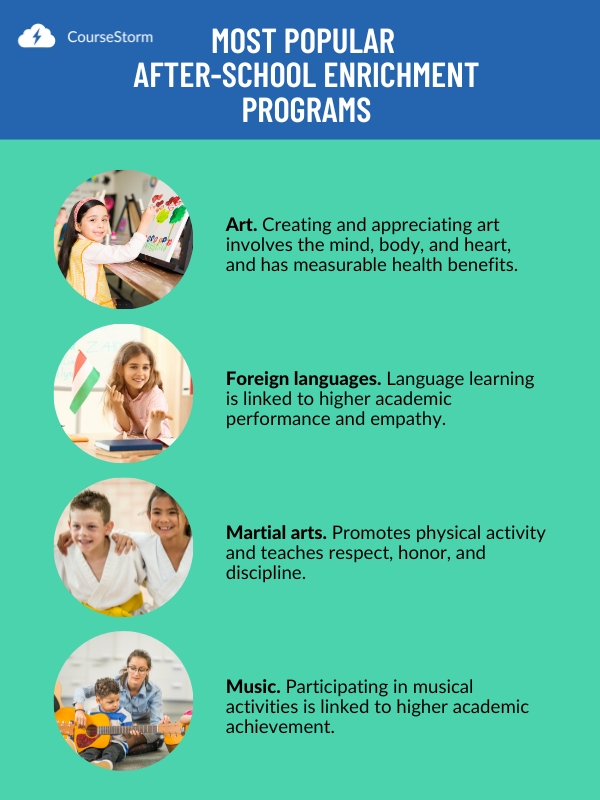
Why Are After-School Programs Important?
Naturally, parents want their children to be safe and supervised after school. There are many benefits to after school programs beyond providing childcare to kids until their parents are done with work, however. In fact, afterschool programs have been shown to improve participants’ performance at school, reduce crime and juvenile delinquency, and provide a significant return on investment through increasing students’ earning potential.
Afterschool programs have been shown to improve school performance, reduce crime, and increase students’ future earning potential.
Data from the Afterschool Alliance, a nonpartisan, nonprofit organization whose mission is to ensure that all children have access to affordable, quality afterschool programs, found the following benefits of afterschool programs:
- Access to caring adults and mentors
- Help children develop social skills and life skills
- Help develop confidence and responsible decision-making
- Reduce the likelihood of children engaging in risky behaviors
- Provide opportunities for physical activity
These findings are more important than ever, given that loneliness and youth mental health issues skyrocketed during the pandemic.
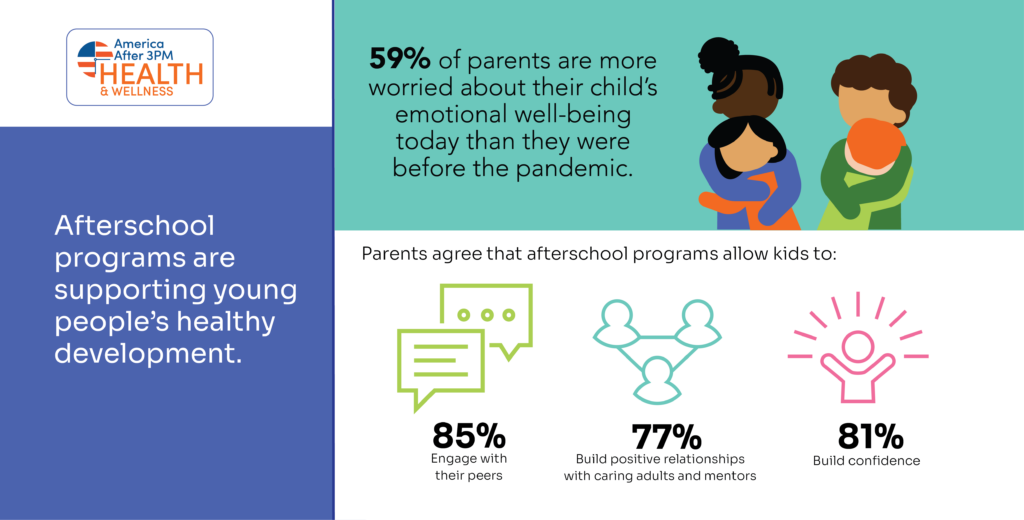
Source: AfterschoolAlliance.org
What Do Parents Look for in Afterschool Enrichment Programs?
To market after-school programs in your community, you first need to understand what’s important to parents and caregivers who will be looking for, evaluating, and ultimately registering their children for afterschool activities.
Transportation may be an issue for many parents if an enrichment program is not at their child’s school, so if your program does or does not include transportation, be sure to note that in your marketing materials and program descriptions.
It’s also a good idea to note whether a snack is included, and if students are given time to complete homework. For some parents, having a place where students can work on assignments and get help if needed is a huge benefit that avoids evening homework battles.
Some community organizations like the Y offer before and after school enrichment programs that start as early as 7 a.m. and are available to students 5 days a week or only 2 or 3 days a week. Perhaps with flexible scheduling, your program could fill a need for parents that other programs don’t.
Demand has skyrocketed: for every child in an afterschool program, three are waiting to get in.
Unmet demand for after-school enrichment programs has skyrocketed. For every child in an afterschool program, three are waiting to get in, according to the Afterschool Alliance. With the right marketing and a simple, parent-friendly registration tool, your afterschool program can be the solution families are looking for.
CourseStorm serves many customers offering after-school activities and enrichment classes. Features like group registration and emailed waiting list invites make for a simple and seamless experience for both families and your program staff. Get in touch with us today for a demo!

